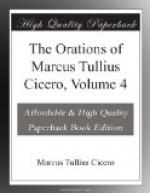heroic rhythm is a grander one than is admissible in
prose, and that an iambic is too like ordinary conversation.
Accordingly, he does not approve of a style which
is lowly and abject, or of one which is too lofty
and, as it were, on stilts: but still he wishes
for one full of dignity, in order to strike those
who hear it with the greater admiration. But
he calls a trochee, which occupies the same time as
a choreus, [Greek: kordax], because its contracted
and brief character is devoid of dignity. Accordingly,
he approves of the paeon; and says that all men employ
it, but that all men are not themselves aware when
they do employ it; and that there is a third or middle
way between those two, but that those feet are formed
in such a way, that in every one of them there is
either a time, or a time and a half, or two times.
Therefore, those men of whom I have spoken have considered
convenience only, and disregarded dignity. For
the iambic and the dactyl are those which are most
usually employed in verse; and, therefore, as we avoid
verses in making speeches, so also a recurrence of
these feet must be avoided. For oratory is a different
thing from poetry, nor are there any two things more
contrary to one another than that is to verses.
But the paeon is that foot which, of all others, is
least adapted to verse, on which account oratory admits
it the more willingly. But Ephorus will not even
admit that the spondee, which he condemns, is equivalent
to the dactyl, which he approves of. For he thinks
that feet ought to be measured by their syllables,
not by their quantity; and he does the same in regard
to the trochee, which in its quantity and times is
equivalent to an iambic; but which is a fault in an
oration, if it be placed at the end, because a sentence
ends better with a long syllable.
And all this, which is also contained in Aristotle,
is said by Theophrastus and Theodectes about the paeon.
But my opinion is, that all feet ought to be jumbled
together and confused, as it were, in an oration;
and that we could not escape blame if we were always
to use the same feet; because an oration ought to
be neither metrical, like a poem, nor inharmonious,
like the conversation of the common people. The
one is so fettered by rules that it is manifest that
it is designedly arranged as we see it; the other
is so loose as to appear ordinary and vulgar; so that
you are not pleased with the one, and you hate the
other.
Let oratory then be, as I have said above, mingled
and regulated with a regard to rhythm; not prosaic,
nor on the other hand sacrificed wholly to rhythm;
composed chiefly of the paeon, (since that is the
opinion of the wisest author on the subject,) with
many of the other feet which he passes over intermingled
with it.




